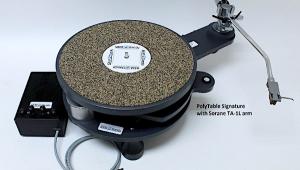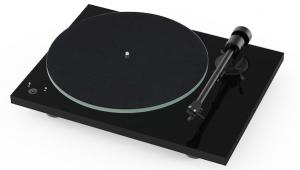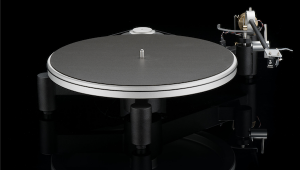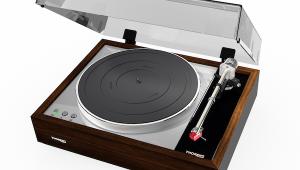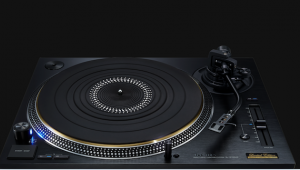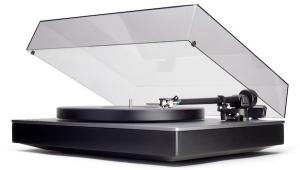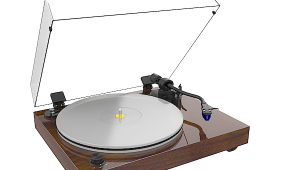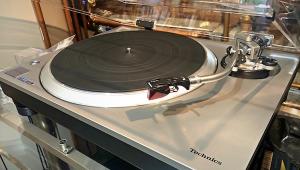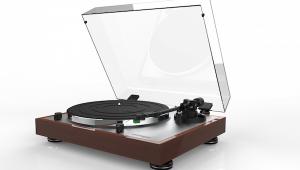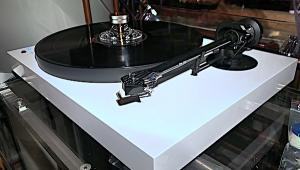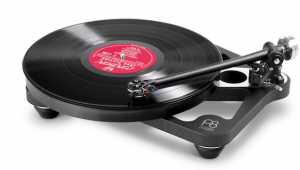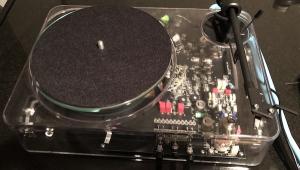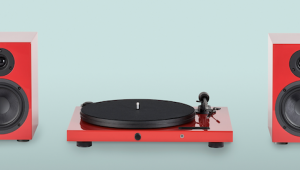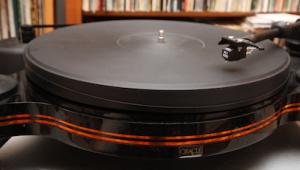So, for $2995 they can't afford to include a stroboscope and some means of speed/pitch adjustment?
Rega Research RP8 Turntable Aims For Mass Extinction
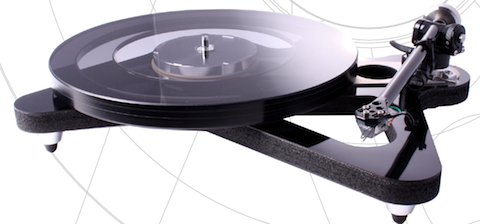
Obviously swimming upstream is both literally and figuratively more difficult than swimming downstream. Turntable manufacturers starting with pricey ‘statement’ designs usually, but not always, have an easier time producing lower priced ‘tables.
In the 1970s Rega Research began building “real world” priced, low mass, unsuspended turntables, sourcing tone arms from Danish and Japanese suppliers. Rega’s early ‘tables sounded fast, pleasingly lean, and rhythmically assured compared to their lumbering brethren.
Rega’s decision in the early 1980s to invest in the expensive tooling required to manufacture a rigid, one-piece cast tone arm as the compact disc’s introduction loomed, produced both immediate and long term sonic and financial benefits: in addition to greatly improving the sonic performance of its own ‘tables with the new RB250 and RB300 tone arms, the company began selling to turntable manufactures around the world OEM versions of the arms.
Throughout the years Rega has remained true to its design philosophy of low mass, high rigidity, unsuspended, motor-onboard construction, sticking with the O-ring driven sub platters and felt mat topped glass platters—all the while incrementally “swimming upstream” with products that outperformed previous efforts.
A few years ago when the original arm casting finally wore out, Rega set about re-designing the arm, this time aided by computer modeling. Though the new and improved edition looks superficially like the one it replaced, significant changes were made to mass distribution that improves both the arm’s dynamic performance and its resonance damping abilities.
Rega’s farthest upstream swim produced the now discontinued $4995 Rega P9, which replaced the ubiquitous single O-ring driven plastic hub with one machined of aluminum driven by dual O-rings, and swapped out the usual glass platter with one of ceramic fabricated from a material similar to what’s used on some guided missile nose cones, along with a host of other upgrades including the RB1000, the finest expression of the basic Rega tone arm. A single tone arm specialist could produce dozens of RB300 arms in the time it took to assembly and tweak a single RB1000.
New RP 8 “Pokes Holes” In Rega’s Design Philosophy
Rega has always been about rigid, low mass plinths and modest mass platters. The company’s latest series of turntables has taken that concept to high tech extremes with sonically outstanding results.
How good does Rega think its new RP8 performs and sounds? The company discontinued the P9 because it claims the RP8 comes oh so close sonically while costing far less. The upcoming P9 replacement, the RP10, will be even better, the company promises.
If you thought Rega ‘tables were low mass before, have a look at the new skeletal RP8. It is the company’s most rigid, lowest mass design yet. The outer frame serves mainly to hold the dust cover and can be left in the shipping box if you don’t feel the need for plastic dust and/or people (or pussycat) protection.
That leaves the asymmetrical skeletal frame, fabricated from a Rega-specified version of Zotek® a new “space age” polyolephin foam that’s both ultra-rigid and ultra-low mass. According to Rega CEO and 30 plus year Rega veteran Phil Freeman, the material begins as a shoebox sized block that’s saturated with nitrogen gas and then “shock vacuumed” in a compression chamber, shrinking it down to a thin, rigid, symmetrical, closed-cell foam.
The foam is machined and sandwiched between two thin layers of a stressed skin structure of phenolic producing a plinth that is seven times lighter than that of the original Rega 3, while of course being far more rigid.
The ‘table incorporates the previously developed “stress beam” assembly linking the tone arm and platter hub. The top layer of magnesium and bottom layer of phenolic produce increased structural rigidity, while its self-damping properties reduce structural resonances and restrict external energy absorption.
The dust cover-holding outer frame is of the same material as the plinth and appears to be the “left over” from cutting out the skeletal plinth. Its three large feet incorporate elastomer bands that self-center the skeletal plinth’s three elastomer tipped feet and are the plinth’s only frame contact points.
Driving the hub via dual O-rings is a high spec 24V twin-phase motor topped by a CNC machined dual-grooved pulley. As in earlier Regas, each motor is individually tuned to its associated power supply’s anti-vibration circuit incorporated within the outboard TT-PSU power supply. Based upon a high stability crystal locked low distortion sine wave generator, the TT-PSU generates a 24V AC balanced signal with less than 0.05% distortion.
The hub of solid aluminum is similar to the one used on the P9. With the launch a few years ago of the RP3, Rega moved for production of its glass platters to a new high-tech, CNC-based manufacturer, ending a thirty-year relationship with the original glass platter maker. This allowed Rega to add to the platter a bonded outer rim first used on the RP6 that produced a beneficial flywheel effect. The RP8’s newly designed platter shifts the mass still further towards the platter’s perimeter, exponentially increasing the flywheel effect. Freeman claims that the RP8’s drive system equals at a substantially lower cost the quality and performance of the mid-nineties P9.
By the way, speaking on the record about Rega’s resurgence (the company doubled the size of the then new factory I visited in 1999), Freeman told me that when the RP1 was designed and brought to market, he envisioned sales of perhaps 500 a month. Actual monthly sales today are about six times that number!
Also new is the RB808 tone arm. It’s hand-built using improved bearings and a tightened spindle-fit tolerance. It incorporates a new low mass, precision-engineered vertical bearing assembly, a new glossy and very attractive powder coat finish and new, flexible, low capacitance Germany-sourced cables terminated with twist-clamp type plugs.
So what you have here is a very highly evolved edition of Rega’s core concept, built using previously unavailable materials and construction techniques that will set you back $2995 or, $3995 if ordered as a package with a factory installed $1795 Apheta MC cartridge— a saving of a hefty $800 on the cartridge.
Set-Up And Use
Factory-fitted with the Apheta cartridge, set-up is simple, though the two-piece plinth is at first a bit awkward to handle and takes some getting used to. After placing the platter on the hub, level the plinth using the three threaded elastomer-tipped feet, put the counterweight onto the stub and with the tracking force spring set to zero, balance the arm, then apply the 1.75 gram VTF.
(Three unknown variables were two too many so after a few day’s listening to the Rega trio, for most of my listening, I used known cartridges into known phono preamps, returning to the Rega trio towards the end of the review period.)
If you don’t look very carefully you won’t see the gram markings on the tracking force adjustment ring. In fact, until Freeman alerted me to them, I thought Rega had done away with tracking force markings on this arm. Set the anti-skating according to the instructions, plug the multi-pin plug into the TT-PSU, the “wal-wart” into the PSU and the phono cables into the MC input of your phono preamp, and once you’ve removed the stylus guard you’re ready for vinyl action!
Remember though, that the three point cartridge mount uses Rega’s unusual alignment geometry that minimizes distortion at the inner groove area while maximizing it elsewhere along the arc the stylus traces. It’s best for classical music only in my opinion.
While this makes for a relatively fast, easy set-up, particularly for novices, veterans wishing to use their cartridge choice will note that as has always been the case with Rega tone arms, there’s no easy way to adjust either VTA/SRA or azimuth.
Using Acoustic Signature’s ingenious shims, it’s possible to raise the back of the arm without first removing it, but if proper 92 degree SRA setting requires lowering the arm, the only solution is to use a thicker mat to raise the platter relative to the arm pivot.
If your cartridge hasn’t been perfectly constructed (too few are) and cantilever perpendicularity to the record surface isn’t the optimum azimuth setting, you are again out of luck. Rega’s position here as it has always been is that structural rigidity trumps all other considerations.
Rega sent along one of its new $1495 Aria MM/MC phono preamplifiers reviewed here) so I began listening to the RP8 with the Apheta cartridge, and Aria phono preamp, but not until I let the platter spin for a few hours to give it some break-in time.
- Log in or register to post comments


That's a steep upcharge just to get the model with speed adjustment.
Before spending $3K for an RP8, I'd want to try a SOTA Jewel (with an SME M2 tonearm) for comparison.

Good review. A couple serious "but if's", however.
In the RP-8 review it was stated something like "assuming it's just this one" !
Give me a break. Rega (since the 1980's) are known for this indifference (to speed variation/inconsistency).
As a reviewer, you should always assume that what you have is a "representative" sample, not some worn-out reviewer model, unless proven otherwise.
Furthermore, Rega's early tonearms were "shite" --plain & simple. That they continue to pretend to know what their doing is laughable. (Rigidity Above All Else is far too long-in-tooth, simplistic and plain wrong. No VTA, Azimuth etc.).
Mercifully, we have actual engineers and creative folk out there that offer up alternatives to the self-professed wisdom of Rega's founder (and/or its engineering principles).
Yet, many thousands (of unsuspecting?) consumers lead the way -- assuming Rega sales are brisk?
As noted, at such a price point (as the RP-8), speed accuracy and consistency should be (should be demanded to be) precise and unwavering. If not, look elsewhere. Lots of serious-minded manufacturers exist in today's marketplace. You can thank me later.
peter jasz

Hi Peter. As a RP8 (with Exakt 2 cartridge) owner, I wanna ask you what turntable in the same price range of the RP8 might surpass it sonically in your opinion? VPI is out of the question here in Italy because the price increae from US to EU is quite hefty.

Hi Nello: You have a fine turntable -keep enjoying.
My experience with tables/arms/cartridges, phono-stages etc. has been minimal over the past ten years. I'm not one who has the required (current) experience required for a sensible alternative recommendation.
I do not know the pricing of your Rega combination (with arm & cartridge), but an excellent table/arm is the Marantz (Clearaudio?)"TT-1". It's a wonderful sounding kit (with included $800. cartridge). In Canadian dollars, the TT-1 package price (depending on tracker)ranges between $1,800-$2,300. (CA$).
I'd also consider many of Clearaudio's excellent product. Or, perhaps One of Funk Firm's designs. No doubt, there are other equally respected designs available.
I believe you'd find enormous improvements if you could substitute the Rega tonearm (assuming it is a Rega) with another, one offering VTA, Azimuth and height adjustments.
Rega's "spacer" deal (for height adjustment)is the most ridiculous and unnecessary design criteria devised -only from the mind of RG): I envision a man with a closet full of 'superstitions" parading as clever design criteria.
You have a very nice, capable T/T. Keep enjoying !
Happy New Year,
pj

You forgot to mention the RP808 tonearm uses the same cheap cartridge wire connections as the RP303 which at $3.000.00 is a crime. Roy Gandy is a cheapskate.

I haven't heard the table, but I like the sound of your adjectives. One object layered on another, in a brief rippling rhythm, riding on the slippery "Ss" and coming to rest on a final welcoming subjective impression. "The RP8 floated a solid, stable, supple and pleasingly silky image between the speakers-" You have a gift for evocative economy without a bit of scarcity. It's really no wonder that you weren't using pussycat protection.

that the RP10 looks like an RP8 with the holes filled in, and a wider plinth.

Hi Mike,
It seems like the RP6 is the "sweet spot" in the Rega lineup. However, both Stereophile and Analog Planet appear to have skipped over it, instead covering the RP3 and RP8. Where does the RP6 fit into the price/performance equation of the Rega offerings?

It's been said that listener's find 'sped-up' speed to sound "better/more enjoyable".
Rega, one of the longest standing makers of some really decent sounding tables (with the right arm/cartridge) should have the resources, stability but appear to lack the desire to consider product improvements that have been historically weak.
Indeed, when I read: "I know the P series runs fast (possibly by intention?)" I'd suspect this is either a desirable characteristic for Rega tables or sheer indifference. It's likely a combination of both with a heavenly dash of arrogance.
pj

my rp6 run a bit fast too with the rega drive belts but when i put on the edwards audio little belter drive belt it was spot on don't know if that would make this turntable run on speed or not

Don't they purposely run their tables a little faster to compensate for stylus drag?

Is this essentially an internet version of the Stereophile review of the RP8 based on your experinece with that review sample? It's true when you buy a Rega some of that goes to UK labor Brother John and parts costs are curtailed, yea it seems cheap, you are'nt buying Chinese here, when I buy a Rega I am partly helpng a working man to earn a living in the companys home country. At the upper price level of the 8 it does seem a few audiophile spec parts could have been added. But I'd gurantee you Gandy thinks cartridge clips are inaudible. The platter on a P3 used to be more robust and the arm used to have the tungsten weight as standard, and where there was metal is now plastic. Are the changes audible? Has Rega moved things foward in spite of this? you'd have to take out an old 3 and compare to the current version. I have an RP8 slightly fast out of box and I did a reoil with 90w gear oil, now I have never had a Rega more speed true than this. Neither have I ever had a table that sounds this good. Re Plinth maybe tapping it transmits easily, rather than tap the plinth- put on a record fairly loud and feel the plinth as the music is playing- music vibrations are rejected better than the older plinths. I am convinced Rega factory adjusts their tables to run slightly fast on purpose but will never admit it. Mr. Fremer is correct about Regas being generally fast since his review experience meshes with my user experience even with accounting for stylus drag (and he is to be commended for writing the only recent Rega review I know of to point this out and give criticism where its due, though I do remember a long ago Hi fi choice review of a Rega indicating similar results). I hope they send him an RP10 to take for a spin. Btw Where does Rega say the RP10 has speed control? that would be very un-Rega like. Here is what they say on their site: "Factory set vibration and speed adjustments are then made to the power supply to tune the motor for optimal performance."

"low mass, unsuspended turntables.... compared to their lumbering brethren.... its design philosophy of low mass, high rigidity, unsuspended, motor-onboard construction, .... rigid, low mass plinths and modest mass platters.... the company’s latest series of turntables has taken that concept to high tech extremes .... If you thought Rega ‘tables were low mass before, have a look at the new skeletal RP8.... It is the company’s most rigid, lowest mass design yet. .... both ultra-rigid and ultra-low mass.... a plinth that is seven times lighter than that of the original Rega 3"
Having placed so much emphasis on the plinth's low mass, do you happen to know what it weighs, please?

clips coaster92 although your thesis about British labor and Mr. Gandy's assessment make perfect sense.
As an owner of an old Rega P25 Turntable I have unfortunate past experience with that companies cheap cartridge clips breaking off while changing cartridges as well as their connectors being too small to fit properly onto the pins of a few non-Rega brands. A more robust clip like the one VPI uses even on their cheapest tonearm doesn't stand the chance of breaking off while mounting new cartridges.
I will not ever purchase another Rega TT because of this Issue.
My next upgrade will most likely be one of the VPI classic models.
VPI products are not manufactured in China either but New Jersey all while avoiding the use of cheap tonearm connections on their $3K turntable/Tonearm and paying their employees a real wage.

I have an RP8 and can confirm that it runs fast. 33.56rpm and 45.53 per Turntabulator app on iPhone. Same app gave me 33.33 on my expertly setup Linn LP12 outfitted with Hercules power supply.
Funny how the Rega tables always seem to run a little fast but never a little slow.
Also can confirm that it sounds fantastic. Would prefer accurate speed.

Hi,
As you have a Rega RP8. Can you please share your experience regarding tonearm vibrations at 45 rpm.
Cheers,
Jim

I have Rega RP 6 with a few mods like a Groovetracer® reference subplatter and Tangospinner Golden - Brass Pulleys set Triple pulley and the ACRYLIC PLATTER UPGRADE for Rega RP6 turntable 30mm so now I ready to buy the Ortofon MC Cadenza Black Cartridge (Moving Coil and the that sells in Australia for $3000 so just asking everyone out there is this a over kill for the Rega PR 6 ? thanks

So I have the Rega RP8 and in my opinion it has a design flaw. Every time I increase the speed of the deck to 45rpm I can feel the vibrations of the motor coming through the tonearm. Yes on a turntable that costs in UK around £2500 the tonearm vibrates. In order to cure the situation I have tried everything from changing the feet to aluminium ones, buying a heavy wooden block, and finally putting a layer of sorbothane underneath the table. But nothing has helped. Reading this article I see that Michael also mentioned that the motor suffers from hum and the plinth is very live, this can only translate into a motor vibration problem. I am not sure why did issue has not been reported widely.

During all the years REGA has been active in turntable manufacturing, there are still unbelievable statements that come with their products. And those that are essential are still simply ignored. Such as useable technical specifications. Why are the potential customers left in the dark? Is it perhaps the e.g. wow & flutter figures are not so good? Why are those rediculous statements by Gandy as for leaving dust on the records as "the stylus will push that aside" still in their documentations that come with their products? Or that we should not believe other manufacturers' recommendations? These facts alone keep me away from REGA. No matter how the products sound, no matter how popular they might be. Simply not for me. Because I know Gandy did not invent the medium, others did that. And others perfected the medium, not Gandy. In fact during the foundation of REGA there were already pretty good sounding products on the market that still outperform so many modern day turntables, e.g. the DUAL 701. So no, Mr. Gandy. You may be stubbornly continue to influence the newbees, once they heard what good vintage equipment is capable of they will doubt your rediculous statements.

Extraordinary things you've generally imparted to us. Simply continue written work this sort of posts.The time which was squandered in going for educational cost now it can be utilized for studies.Thanks certified translation services las vegas

When I was preparing documents for submission abroad, it was important for me not just to "get it done somehow", but to be sure that everything was done correctly. Especially in Canada, where the system is different - apostille is not used, there is only an authentication process. I compared several services and chose https://www.legalizationservicecentre.ca/apostille-canada/ , because they provide a clear structure, do not promise "super-fast", but do it reliably. It feels like it.




